Proposal: Leadership and Management Impact on Virgin Group Employees
VerifiedAdded on 2019/12/04
|13
|4395
|150
Project
AI Summary
This proposal outlines a research project that investigates the influence of contingent leadership and management styles on employee performance, using the Virgin Group as a case study. The study aims to analyze the significance of leadership and management, examine various contingent leadership styles (autocratic, participative, and free-rein), assess their impact on employee performance, and recommend strategies for enhancing employee outcomes. The research will employ a descriptive research design, focusing on data collection from secondary sources such as books and journals, and will include a Gantt chart for project management. The proposal highlights the importance of leadership in today's competitive environment, emphasizing how different leadership approaches affect employee behavior and performance. The study's rationale stems from the need to adapt leadership styles to changing business conditions and the significance of identifying effective management practices for improved employee performance. The project's findings are intended to benefit both researchers and businesses seeking to optimize leadership strategies for organizational success.
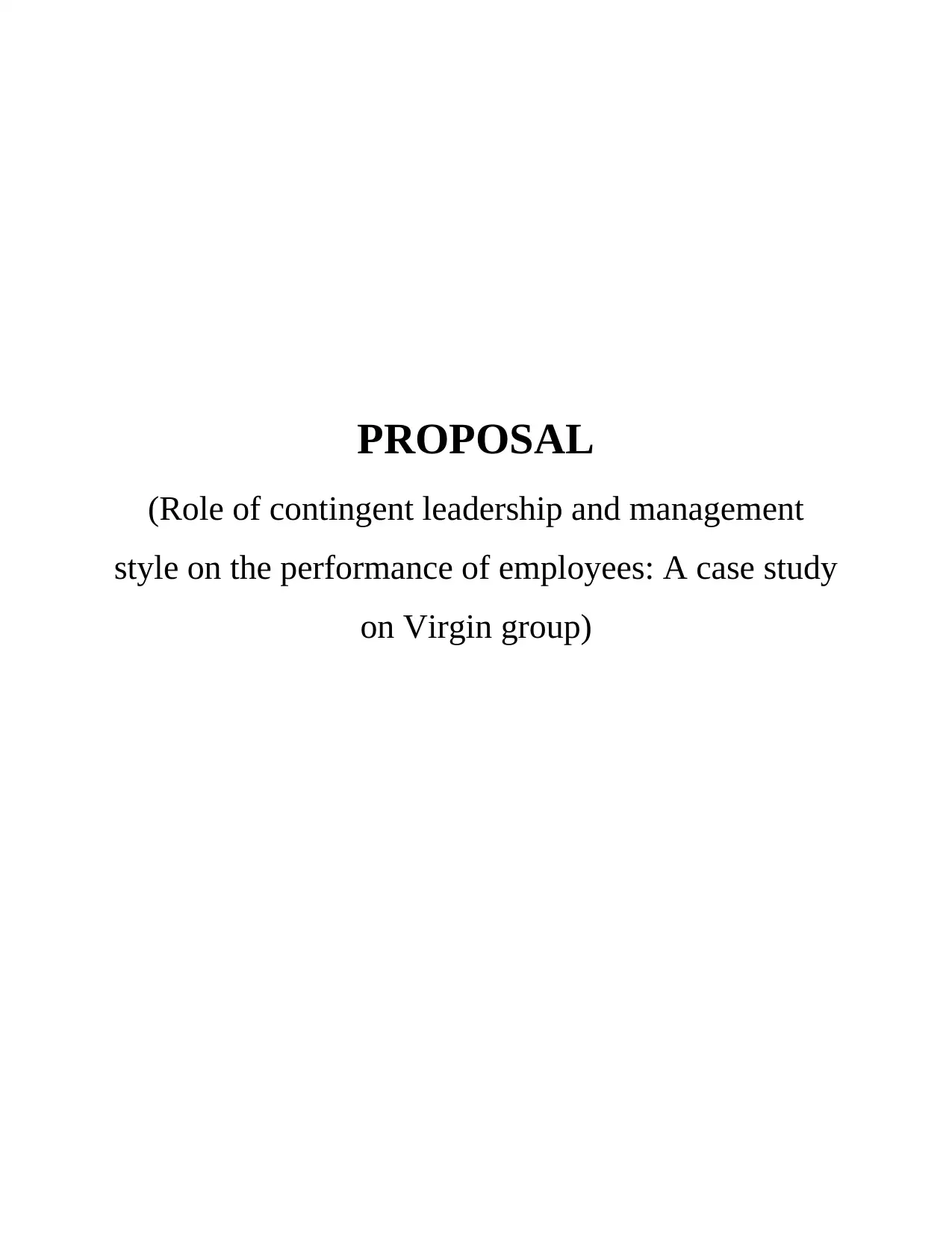
PROPOSAL
(Role of contingent leadership and management
style on the performance of employees: A case study
on Virgin group)
(Role of contingent leadership and management
style on the performance of employees: A case study
on Virgin group)
Paraphrase This Document
Need a fresh take? Get an instant paraphrase of this document with our AI Paraphraser
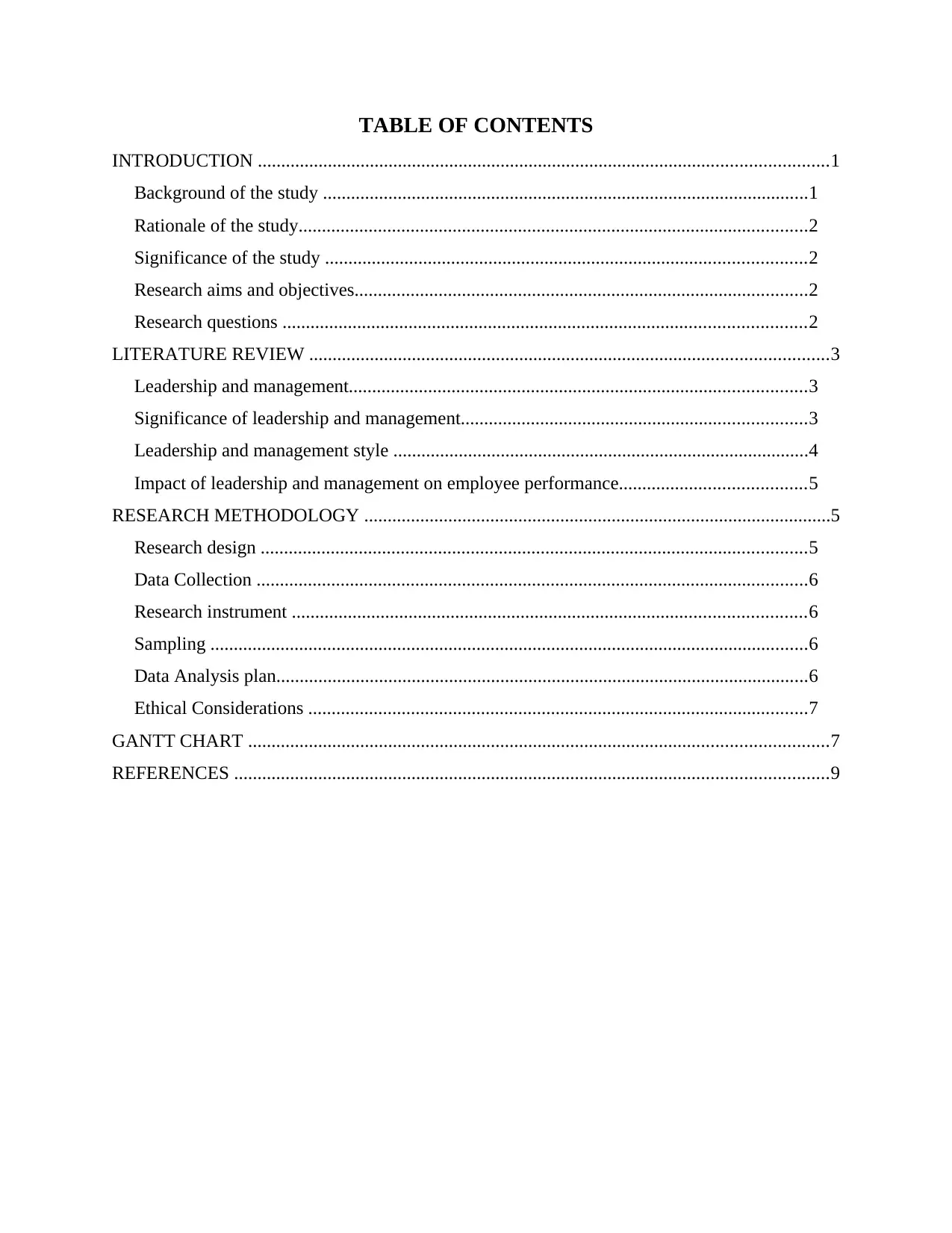
TABLE OF CONTENTS
INTRODUCTION ..........................................................................................................................1
Background of the study ........................................................................................................1
Rationale of the study.............................................................................................................2
Significance of the study .......................................................................................................2
Research aims and objectives.................................................................................................2
Research questions ................................................................................................................2
LITERATURE REVIEW ...............................................................................................................3
Leadership and management..................................................................................................3
Significance of leadership and management..........................................................................3
Leadership and management style .........................................................................................4
Impact of leadership and management on employee performance........................................5
RESEARCH METHODOLOGY ....................................................................................................5
Research design .....................................................................................................................5
Data Collection ......................................................................................................................6
Research instrument ..............................................................................................................6
Sampling ................................................................................................................................6
Data Analysis plan..................................................................................................................6
Ethical Considerations ...........................................................................................................7
GANTT CHART ............................................................................................................................7
REFERENCES ...............................................................................................................................9
INTRODUCTION ..........................................................................................................................1
Background of the study ........................................................................................................1
Rationale of the study.............................................................................................................2
Significance of the study .......................................................................................................2
Research aims and objectives.................................................................................................2
Research questions ................................................................................................................2
LITERATURE REVIEW ...............................................................................................................3
Leadership and management..................................................................................................3
Significance of leadership and management..........................................................................3
Leadership and management style .........................................................................................4
Impact of leadership and management on employee performance........................................5
RESEARCH METHODOLOGY ....................................................................................................5
Research design .....................................................................................................................5
Data Collection ......................................................................................................................6
Research instrument ..............................................................................................................6
Sampling ................................................................................................................................6
Data Analysis plan..................................................................................................................6
Ethical Considerations ...........................................................................................................7
GANTT CHART ............................................................................................................................7
REFERENCES ...............................................................................................................................9
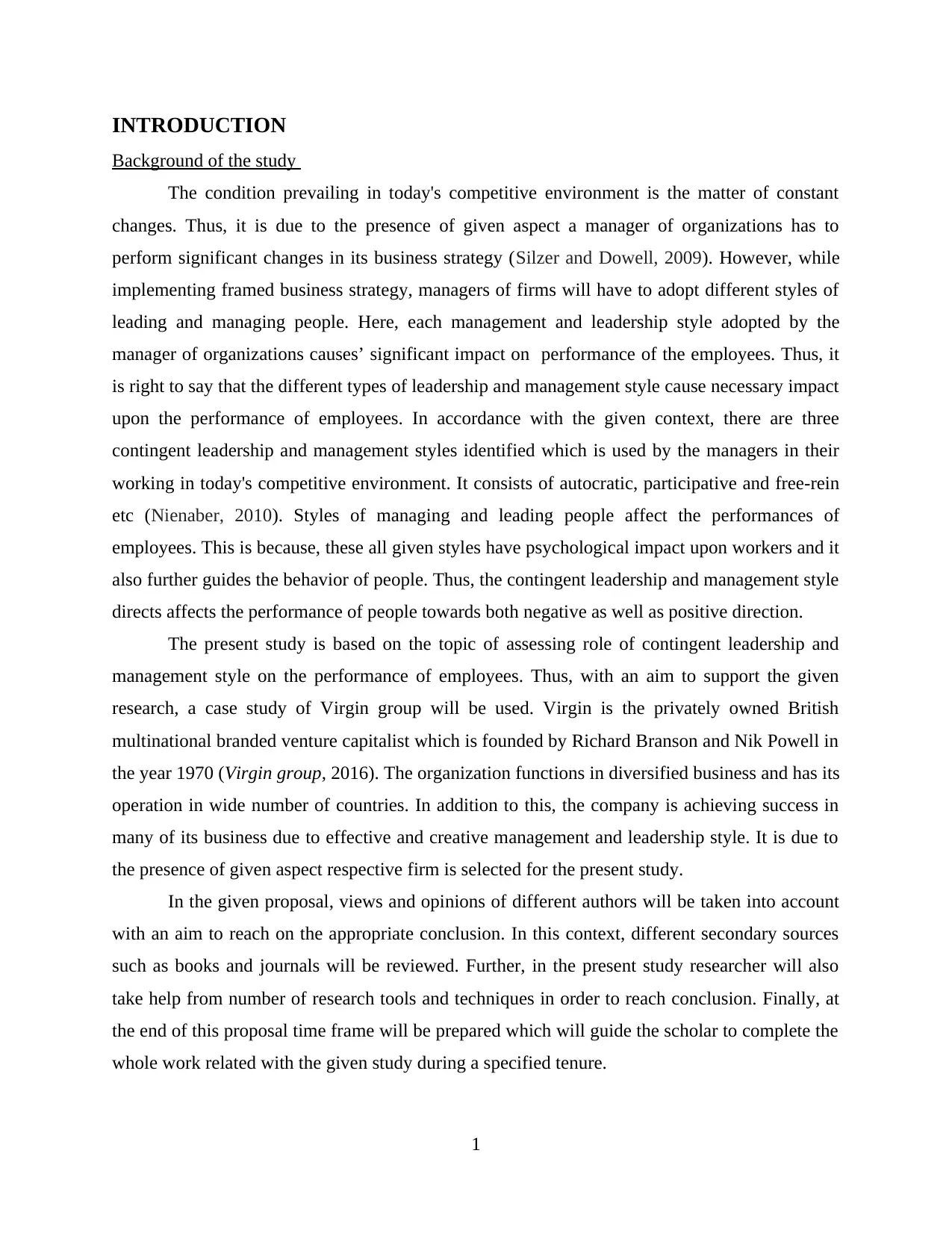
INTRODUCTION
Background of the study
The condition prevailing in today's competitive environment is the matter of constant
changes. Thus, it is due to the presence of given aspect a manager of organizations has to
perform significant changes in its business strategy (Silzer and Dowell, 2009). However, while
implementing framed business strategy, managers of firms will have to adopt different styles of
leading and managing people. Here, each management and leadership style adopted by the
manager of organizations causes’ significant impact on performance of the employees. Thus, it
is right to say that the different types of leadership and management style cause necessary impact
upon the performance of employees. In accordance with the given context, there are three
contingent leadership and management styles identified which is used by the managers in their
working in today's competitive environment. It consists of autocratic, participative and free-rein
etc (Nienaber, 2010). Styles of managing and leading people affect the performances of
employees. This is because, these all given styles have psychological impact upon workers and it
also further guides the behavior of people. Thus, the contingent leadership and management style
directs affects the performance of people towards both negative as well as positive direction.
The present study is based on the topic of assessing role of contingent leadership and
management style on the performance of employees. Thus, with an aim to support the given
research, a case study of Virgin group will be used. Virgin is the privately owned British
multinational branded venture capitalist which is founded by Richard Branson and Nik Powell in
the year 1970 (Virgin group, 2016). The organization functions in diversified business and has its
operation in wide number of countries. In addition to this, the company is achieving success in
many of its business due to effective and creative management and leadership style. It is due to
the presence of given aspect respective firm is selected for the present study.
In the given proposal, views and opinions of different authors will be taken into account
with an aim to reach on the appropriate conclusion. In this context, different secondary sources
such as books and journals will be reviewed. Further, in the present study researcher will also
take help from number of research tools and techniques in order to reach conclusion. Finally, at
the end of this proposal time frame will be prepared which will guide the scholar to complete the
whole work related with the given study during a specified tenure.
1
Background of the study
The condition prevailing in today's competitive environment is the matter of constant
changes. Thus, it is due to the presence of given aspect a manager of organizations has to
perform significant changes in its business strategy (Silzer and Dowell, 2009). However, while
implementing framed business strategy, managers of firms will have to adopt different styles of
leading and managing people. Here, each management and leadership style adopted by the
manager of organizations causes’ significant impact on performance of the employees. Thus, it
is right to say that the different types of leadership and management style cause necessary impact
upon the performance of employees. In accordance with the given context, there are three
contingent leadership and management styles identified which is used by the managers in their
working in today's competitive environment. It consists of autocratic, participative and free-rein
etc (Nienaber, 2010). Styles of managing and leading people affect the performances of
employees. This is because, these all given styles have psychological impact upon workers and it
also further guides the behavior of people. Thus, the contingent leadership and management style
directs affects the performance of people towards both negative as well as positive direction.
The present study is based on the topic of assessing role of contingent leadership and
management style on the performance of employees. Thus, with an aim to support the given
research, a case study of Virgin group will be used. Virgin is the privately owned British
multinational branded venture capitalist which is founded by Richard Branson and Nik Powell in
the year 1970 (Virgin group, 2016). The organization functions in diversified business and has its
operation in wide number of countries. In addition to this, the company is achieving success in
many of its business due to effective and creative management and leadership style. It is due to
the presence of given aspect respective firm is selected for the present study.
In the given proposal, views and opinions of different authors will be taken into account
with an aim to reach on the appropriate conclusion. In this context, different secondary sources
such as books and journals will be reviewed. Further, in the present study researcher will also
take help from number of research tools and techniques in order to reach conclusion. Finally, at
the end of this proposal time frame will be prepared which will guide the scholar to complete the
whole work related with the given study during a specified tenure.
1
⊘ This is a preview!⊘
Do you want full access?
Subscribe today to unlock all pages.

Trusted by 1+ million students worldwide
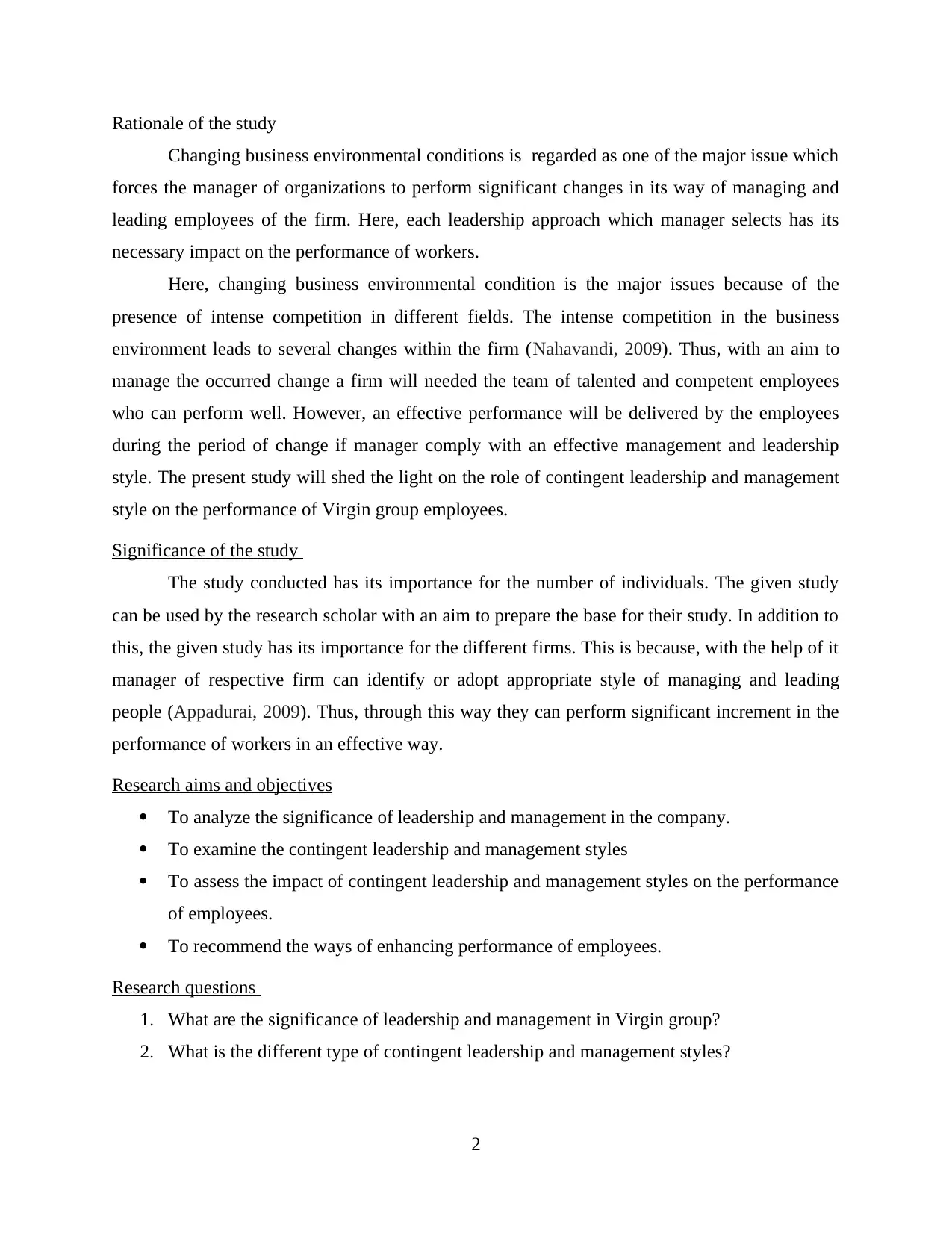
Rationale of the study
Changing business environmental conditions is regarded as one of the major issue which
forces the manager of organizations to perform significant changes in its way of managing and
leading employees of the firm. Here, each leadership approach which manager selects has its
necessary impact on the performance of workers.
Here, changing business environmental condition is the major issues because of the
presence of intense competition in different fields. The intense competition in the business
environment leads to several changes within the firm (Nahavandi, 2009). Thus, with an aim to
manage the occurred change a firm will needed the team of talented and competent employees
who can perform well. However, an effective performance will be delivered by the employees
during the period of change if manager comply with an effective management and leadership
style. The present study will shed the light on the role of contingent leadership and management
style on the performance of Virgin group employees.
Significance of the study
The study conducted has its importance for the number of individuals. The given study
can be used by the research scholar with an aim to prepare the base for their study. In addition to
this, the given study has its importance for the different firms. This is because, with the help of it
manager of respective firm can identify or adopt appropriate style of managing and leading
people (Appadurai, 2009). Thus, through this way they can perform significant increment in the
performance of workers in an effective way.
Research aims and objectives
To analyze the significance of leadership and management in the company.
To examine the contingent leadership and management styles
To assess the impact of contingent leadership and management styles on the performance
of employees.
To recommend the ways of enhancing performance of employees.
Research questions
1. What are the significance of leadership and management in Virgin group?
2. What is the different type of contingent leadership and management styles?
2
Changing business environmental conditions is regarded as one of the major issue which
forces the manager of organizations to perform significant changes in its way of managing and
leading employees of the firm. Here, each leadership approach which manager selects has its
necessary impact on the performance of workers.
Here, changing business environmental condition is the major issues because of the
presence of intense competition in different fields. The intense competition in the business
environment leads to several changes within the firm (Nahavandi, 2009). Thus, with an aim to
manage the occurred change a firm will needed the team of talented and competent employees
who can perform well. However, an effective performance will be delivered by the employees
during the period of change if manager comply with an effective management and leadership
style. The present study will shed the light on the role of contingent leadership and management
style on the performance of Virgin group employees.
Significance of the study
The study conducted has its importance for the number of individuals. The given study
can be used by the research scholar with an aim to prepare the base for their study. In addition to
this, the given study has its importance for the different firms. This is because, with the help of it
manager of respective firm can identify or adopt appropriate style of managing and leading
people (Appadurai, 2009). Thus, through this way they can perform significant increment in the
performance of workers in an effective way.
Research aims and objectives
To analyze the significance of leadership and management in the company.
To examine the contingent leadership and management styles
To assess the impact of contingent leadership and management styles on the performance
of employees.
To recommend the ways of enhancing performance of employees.
Research questions
1. What are the significance of leadership and management in Virgin group?
2. What is the different type of contingent leadership and management styles?
2
Paraphrase This Document
Need a fresh take? Get an instant paraphrase of this document with our AI Paraphraser
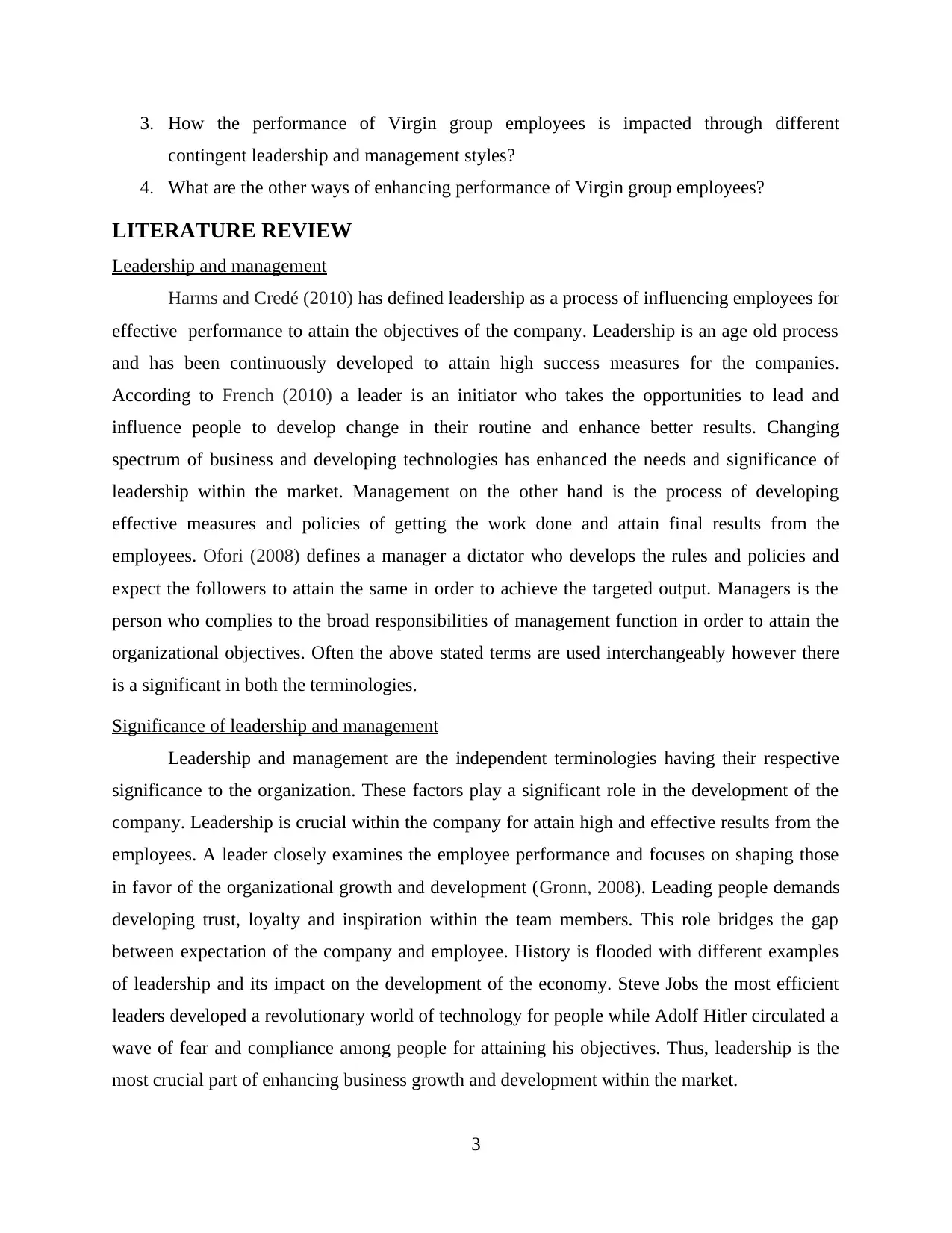
3. How the performance of Virgin group employees is impacted through different
contingent leadership and management styles?
4. What are the other ways of enhancing performance of Virgin group employees?
LITERATURE REVIEW
Leadership and management
Harms and Credé (2010) has defined leadership as a process of influencing employees for
effective performance to attain the objectives of the company. Leadership is an age old process
and has been continuously developed to attain high success measures for the companies.
According to French (2010) a leader is an initiator who takes the opportunities to lead and
influence people to develop change in their routine and enhance better results. Changing
spectrum of business and developing technologies has enhanced the needs and significance of
leadership within the market. Management on the other hand is the process of developing
effective measures and policies of getting the work done and attain final results from the
employees. Ofori (2008) defines a manager a dictator who develops the rules and policies and
expect the followers to attain the same in order to achieve the targeted output. Managers is the
person who complies to the broad responsibilities of management function in order to attain the
organizational objectives. Often the above stated terms are used interchangeably however there
is a significant in both the terminologies.
Significance of leadership and management
Leadership and management are the independent terminologies having their respective
significance to the organization. These factors play a significant role in the development of the
company. Leadership is crucial within the company for attain high and effective results from the
employees. A leader closely examines the employee performance and focuses on shaping those
in favor of the organizational growth and development (Gronn, 2008). Leading people demands
developing trust, loyalty and inspiration within the team members. This role bridges the gap
between expectation of the company and employee. History is flooded with different examples
of leadership and its impact on the development of the economy. Steve Jobs the most efficient
leaders developed a revolutionary world of technology for people while Adolf Hitler circulated a
wave of fear and compliance among people for attaining his objectives. Thus, leadership is the
most crucial part of enhancing business growth and development within the market.
3
contingent leadership and management styles?
4. What are the other ways of enhancing performance of Virgin group employees?
LITERATURE REVIEW
Leadership and management
Harms and Credé (2010) has defined leadership as a process of influencing employees for
effective performance to attain the objectives of the company. Leadership is an age old process
and has been continuously developed to attain high success measures for the companies.
According to French (2010) a leader is an initiator who takes the opportunities to lead and
influence people to develop change in their routine and enhance better results. Changing
spectrum of business and developing technologies has enhanced the needs and significance of
leadership within the market. Management on the other hand is the process of developing
effective measures and policies of getting the work done and attain final results from the
employees. Ofori (2008) defines a manager a dictator who develops the rules and policies and
expect the followers to attain the same in order to achieve the targeted output. Managers is the
person who complies to the broad responsibilities of management function in order to attain the
organizational objectives. Often the above stated terms are used interchangeably however there
is a significant in both the terminologies.
Significance of leadership and management
Leadership and management are the independent terminologies having their respective
significance to the organization. These factors play a significant role in the development of the
company. Leadership is crucial within the company for attain high and effective results from the
employees. A leader closely examines the employee performance and focuses on shaping those
in favor of the organizational growth and development (Gronn, 2008). Leading people demands
developing trust, loyalty and inspiration within the team members. This role bridges the gap
between expectation of the company and employee. History is flooded with different examples
of leadership and its impact on the development of the economy. Steve Jobs the most efficient
leaders developed a revolutionary world of technology for people while Adolf Hitler circulated a
wave of fear and compliance among people for attaining his objectives. Thus, leadership is the
most crucial part of enhancing business growth and development within the market.
3
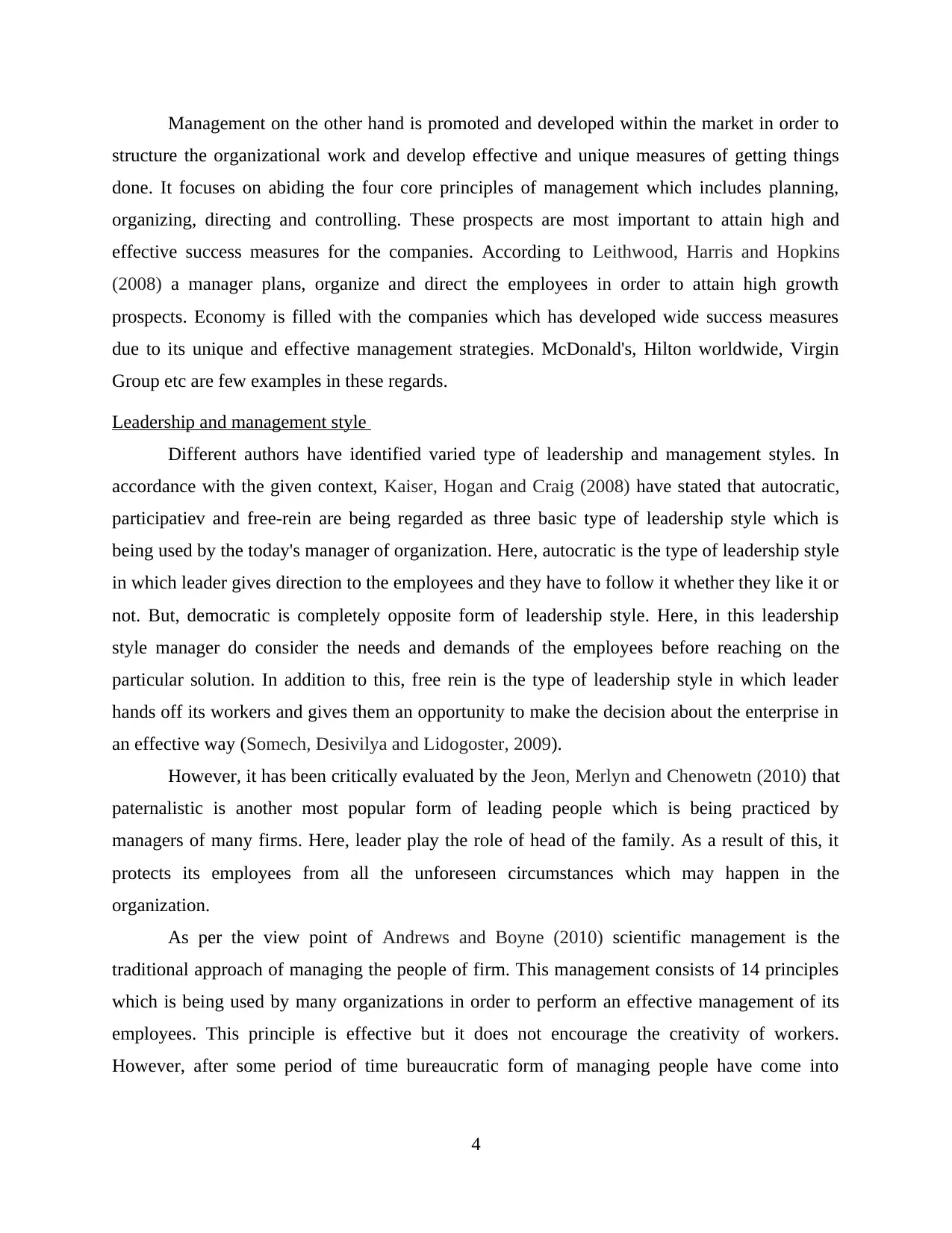
Management on the other hand is promoted and developed within the market in order to
structure the organizational work and develop effective and unique measures of getting things
done. It focuses on abiding the four core principles of management which includes planning,
organizing, directing and controlling. These prospects are most important to attain high and
effective success measures for the companies. According to Leithwood, Harris and Hopkins
(2008) a manager plans, organize and direct the employees in order to attain high growth
prospects. Economy is filled with the companies which has developed wide success measures
due to its unique and effective management strategies. McDonald's, Hilton worldwide, Virgin
Group etc are few examples in these regards.
Leadership and management style
Different authors have identified varied type of leadership and management styles. In
accordance with the given context, Kaiser, Hogan and Craig (2008) have stated that autocratic,
participatiev and free-rein are being regarded as three basic type of leadership style which is
being used by the today's manager of organization. Here, autocratic is the type of leadership style
in which leader gives direction to the employees and they have to follow it whether they like it or
not. But, democratic is completely opposite form of leadership style. Here, in this leadership
style manager do consider the needs and demands of the employees before reaching on the
particular solution. In addition to this, free rein is the type of leadership style in which leader
hands off its workers and gives them an opportunity to make the decision about the enterprise in
an effective way (Somech, Desivilya and Lidogoster, 2009).
However, it has been critically evaluated by the Jeon, Merlyn and Chenowetn (2010) that
paternalistic is another most popular form of leading people which is being practiced by
managers of many firms. Here, leader play the role of head of the family. As a result of this, it
protects its employees from all the unforeseen circumstances which may happen in the
organization.
As per the view point of Andrews and Boyne (2010) scientific management is the
traditional approach of managing the people of firm. This management consists of 14 principles
which is being used by many organizations in order to perform an effective management of its
employees. This principle is effective but it does not encourage the creativity of workers.
However, after some period of time bureaucratic form of managing people have come into
4
structure the organizational work and develop effective and unique measures of getting things
done. It focuses on abiding the four core principles of management which includes planning,
organizing, directing and controlling. These prospects are most important to attain high and
effective success measures for the companies. According to Leithwood, Harris and Hopkins
(2008) a manager plans, organize and direct the employees in order to attain high growth
prospects. Economy is filled with the companies which has developed wide success measures
due to its unique and effective management strategies. McDonald's, Hilton worldwide, Virgin
Group etc are few examples in these regards.
Leadership and management style
Different authors have identified varied type of leadership and management styles. In
accordance with the given context, Kaiser, Hogan and Craig (2008) have stated that autocratic,
participatiev and free-rein are being regarded as three basic type of leadership style which is
being used by the today's manager of organization. Here, autocratic is the type of leadership style
in which leader gives direction to the employees and they have to follow it whether they like it or
not. But, democratic is completely opposite form of leadership style. Here, in this leadership
style manager do consider the needs and demands of the employees before reaching on the
particular solution. In addition to this, free rein is the type of leadership style in which leader
hands off its workers and gives them an opportunity to make the decision about the enterprise in
an effective way (Somech, Desivilya and Lidogoster, 2009).
However, it has been critically evaluated by the Jeon, Merlyn and Chenowetn (2010) that
paternalistic is another most popular form of leading people which is being practiced by
managers of many firms. Here, leader play the role of head of the family. As a result of this, it
protects its employees from all the unforeseen circumstances which may happen in the
organization.
As per the view point of Andrews and Boyne (2010) scientific management is the
traditional approach of managing the people of firm. This management consists of 14 principles
which is being used by many organizations in order to perform an effective management of its
employees. This principle is effective but it does not encourage the creativity of workers.
However, after some period of time bureaucratic form of managing people have come into
4
⊘ This is a preview!⊘
Do you want full access?
Subscribe today to unlock all pages.

Trusted by 1+ million students worldwide
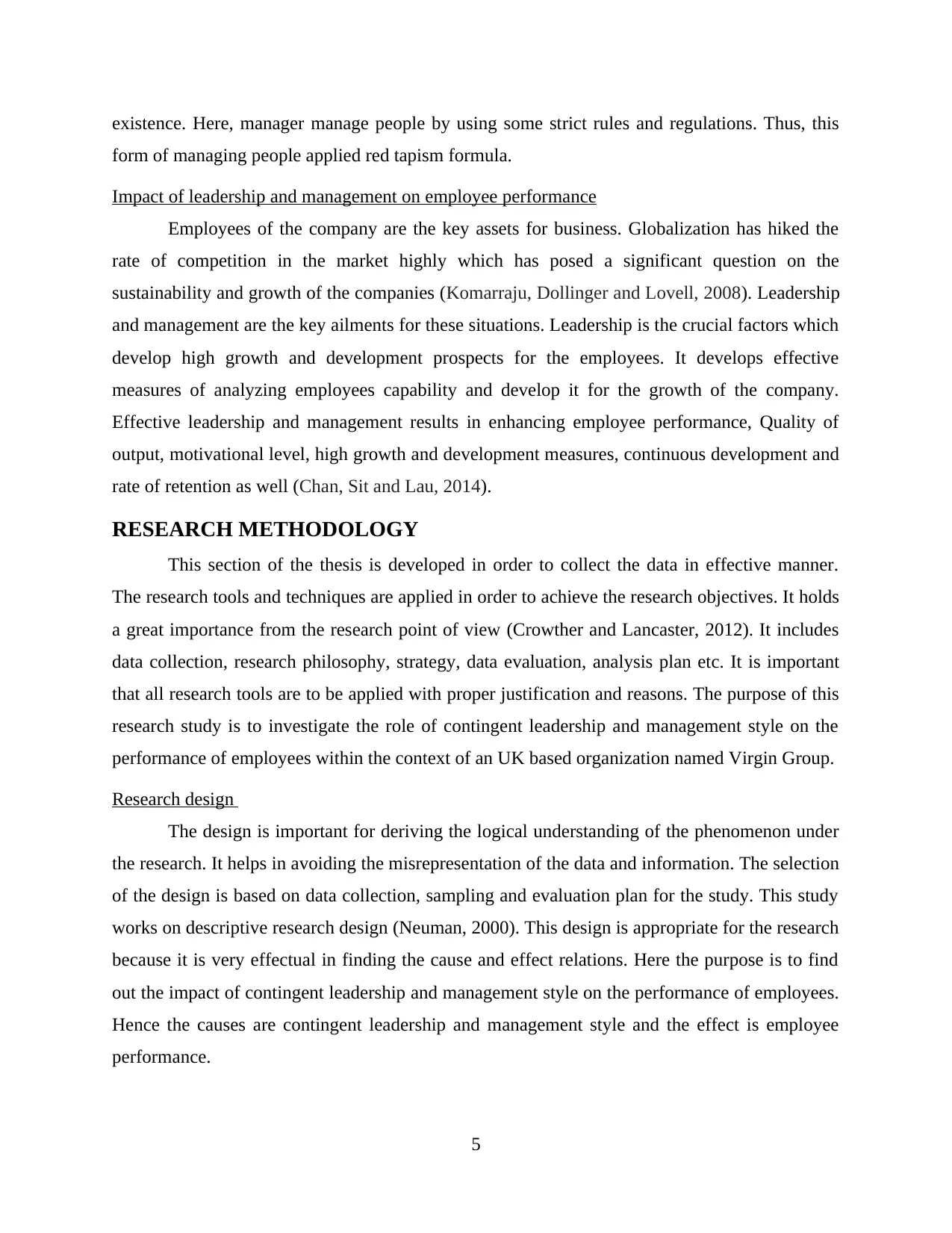
existence. Here, manager manage people by using some strict rules and regulations. Thus, this
form of managing people applied red tapism formula.
Impact of leadership and management on employee performance
Employees of the company are the key assets for business. Globalization has hiked the
rate of competition in the market highly which has posed a significant question on the
sustainability and growth of the companies (Komarraju, Dollinger and Lovell, 2008). Leadership
and management are the key ailments for these situations. Leadership is the crucial factors which
develop high growth and development prospects for the employees. It develops effective
measures of analyzing employees capability and develop it for the growth of the company.
Effective leadership and management results in enhancing employee performance, Quality of
output, motivational level, high growth and development measures, continuous development and
rate of retention as well (Chan, Sit and Lau, 2014).
RESEARCH METHODOLOGY
This section of the thesis is developed in order to collect the data in effective manner.
The research tools and techniques are applied in order to achieve the research objectives. It holds
a great importance from the research point of view (Crowther and Lancaster, 2012). It includes
data collection, research philosophy, strategy, data evaluation, analysis plan etc. It is important
that all research tools are to be applied with proper justification and reasons. The purpose of this
research study is to investigate the role of contingent leadership and management style on the
performance of employees within the context of an UK based organization named Virgin Group.
Research design
The design is important for deriving the logical understanding of the phenomenon under
the research. It helps in avoiding the misrepresentation of the data and information. The selection
of the design is based on data collection, sampling and evaluation plan for the study. This study
works on descriptive research design (Neuman, 2000). This design is appropriate for the research
because it is very effectual in finding the cause and effect relations. Here the purpose is to find
out the impact of contingent leadership and management style on the performance of employees.
Hence the causes are contingent leadership and management style and the effect is employee
performance.
5
form of managing people applied red tapism formula.
Impact of leadership and management on employee performance
Employees of the company are the key assets for business. Globalization has hiked the
rate of competition in the market highly which has posed a significant question on the
sustainability and growth of the companies (Komarraju, Dollinger and Lovell, 2008). Leadership
and management are the key ailments for these situations. Leadership is the crucial factors which
develop high growth and development prospects for the employees. It develops effective
measures of analyzing employees capability and develop it for the growth of the company.
Effective leadership and management results in enhancing employee performance, Quality of
output, motivational level, high growth and development measures, continuous development and
rate of retention as well (Chan, Sit and Lau, 2014).
RESEARCH METHODOLOGY
This section of the thesis is developed in order to collect the data in effective manner.
The research tools and techniques are applied in order to achieve the research objectives. It holds
a great importance from the research point of view (Crowther and Lancaster, 2012). It includes
data collection, research philosophy, strategy, data evaluation, analysis plan etc. It is important
that all research tools are to be applied with proper justification and reasons. The purpose of this
research study is to investigate the role of contingent leadership and management style on the
performance of employees within the context of an UK based organization named Virgin Group.
Research design
The design is important for deriving the logical understanding of the phenomenon under
the research. It helps in avoiding the misrepresentation of the data and information. The selection
of the design is based on data collection, sampling and evaluation plan for the study. This study
works on descriptive research design (Neuman, 2000). This design is appropriate for the research
because it is very effectual in finding the cause and effect relations. Here the purpose is to find
out the impact of contingent leadership and management style on the performance of employees.
Hence the causes are contingent leadership and management style and the effect is employee
performance.
5
Paraphrase This Document
Need a fresh take? Get an instant paraphrase of this document with our AI Paraphraser
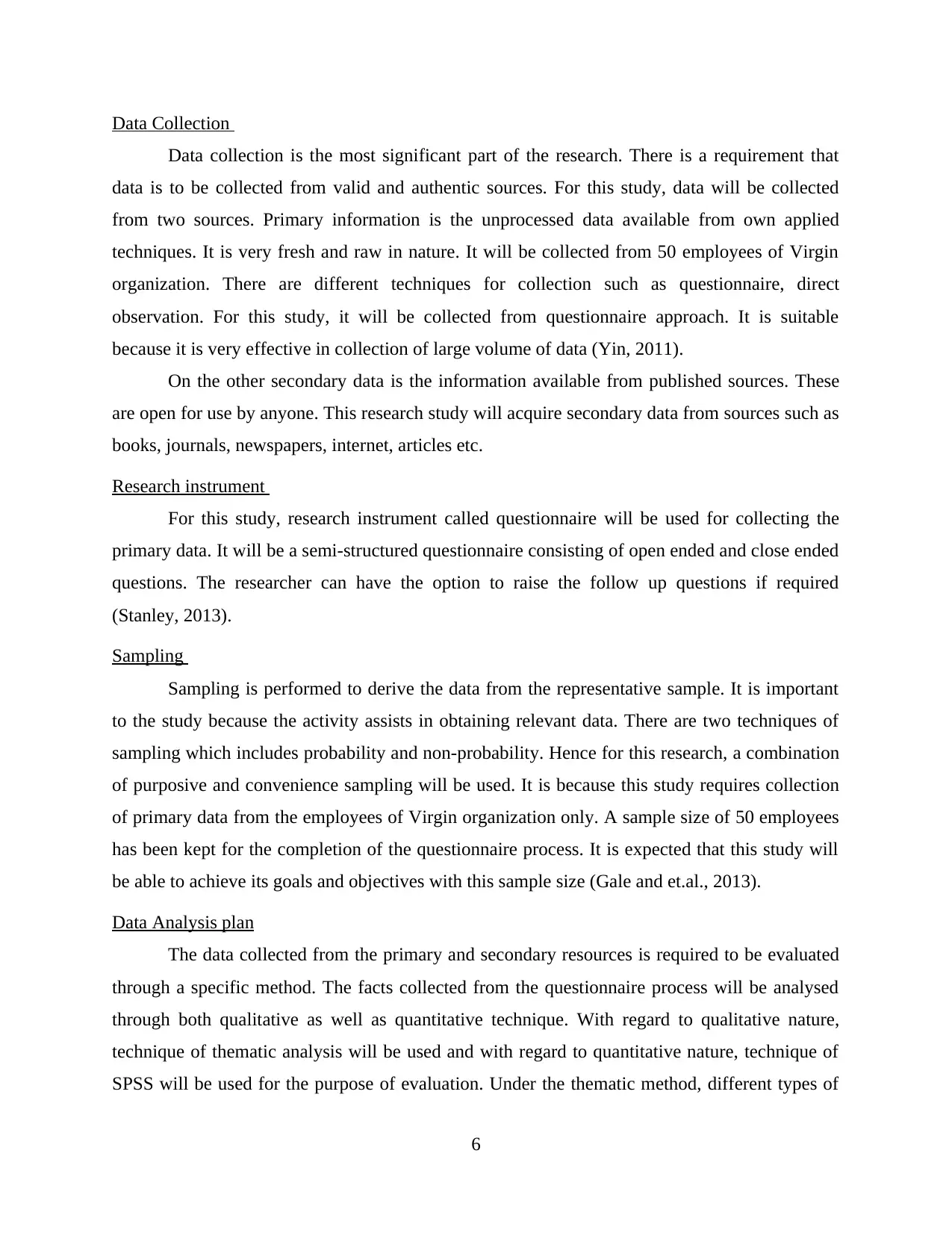
Data Collection
Data collection is the most significant part of the research. There is a requirement that
data is to be collected from valid and authentic sources. For this study, data will be collected
from two sources. Primary information is the unprocessed data available from own applied
techniques. It is very fresh and raw in nature. It will be collected from 50 employees of Virgin
organization. There are different techniques for collection such as questionnaire, direct
observation. For this study, it will be collected from questionnaire approach. It is suitable
because it is very effective in collection of large volume of data (Yin, 2011).
On the other secondary data is the information available from published sources. These
are open for use by anyone. This research study will acquire secondary data from sources such as
books, journals, newspapers, internet, articles etc.
Research instrument
For this study, research instrument called questionnaire will be used for collecting the
primary data. It will be a semi-structured questionnaire consisting of open ended and close ended
questions. The researcher can have the option to raise the follow up questions if required
(Stanley, 2013).
Sampling
Sampling is performed to derive the data from the representative sample. It is important
to the study because the activity assists in obtaining relevant data. There are two techniques of
sampling which includes probability and non-probability. Hence for this research, a combination
of purposive and convenience sampling will be used. It is because this study requires collection
of primary data from the employees of Virgin organization only. A sample size of 50 employees
has been kept for the completion of the questionnaire process. It is expected that this study will
be able to achieve its goals and objectives with this sample size (Gale and et.al., 2013).
Data Analysis plan
The data collected from the primary and secondary resources is required to be evaluated
through a specific method. The facts collected from the questionnaire process will be analysed
through both qualitative as well as quantitative technique. With regard to qualitative nature,
technique of thematic analysis will be used and with regard to quantitative nature, technique of
SPSS will be used for the purpose of evaluation. Under the thematic method, different types of
6
Data collection is the most significant part of the research. There is a requirement that
data is to be collected from valid and authentic sources. For this study, data will be collected
from two sources. Primary information is the unprocessed data available from own applied
techniques. It is very fresh and raw in nature. It will be collected from 50 employees of Virgin
organization. There are different techniques for collection such as questionnaire, direct
observation. For this study, it will be collected from questionnaire approach. It is suitable
because it is very effective in collection of large volume of data (Yin, 2011).
On the other secondary data is the information available from published sources. These
are open for use by anyone. This research study will acquire secondary data from sources such as
books, journals, newspapers, internet, articles etc.
Research instrument
For this study, research instrument called questionnaire will be used for collecting the
primary data. It will be a semi-structured questionnaire consisting of open ended and close ended
questions. The researcher can have the option to raise the follow up questions if required
(Stanley, 2013).
Sampling
Sampling is performed to derive the data from the representative sample. It is important
to the study because the activity assists in obtaining relevant data. There are two techniques of
sampling which includes probability and non-probability. Hence for this research, a combination
of purposive and convenience sampling will be used. It is because this study requires collection
of primary data from the employees of Virgin organization only. A sample size of 50 employees
has been kept for the completion of the questionnaire process. It is expected that this study will
be able to achieve its goals and objectives with this sample size (Gale and et.al., 2013).
Data Analysis plan
The data collected from the primary and secondary resources is required to be evaluated
through a specific method. The facts collected from the questionnaire process will be analysed
through both qualitative as well as quantitative technique. With regard to qualitative nature,
technique of thematic analysis will be used and with regard to quantitative nature, technique of
SPSS will be used for the purpose of evaluation. Under the thematic method, different types of
6
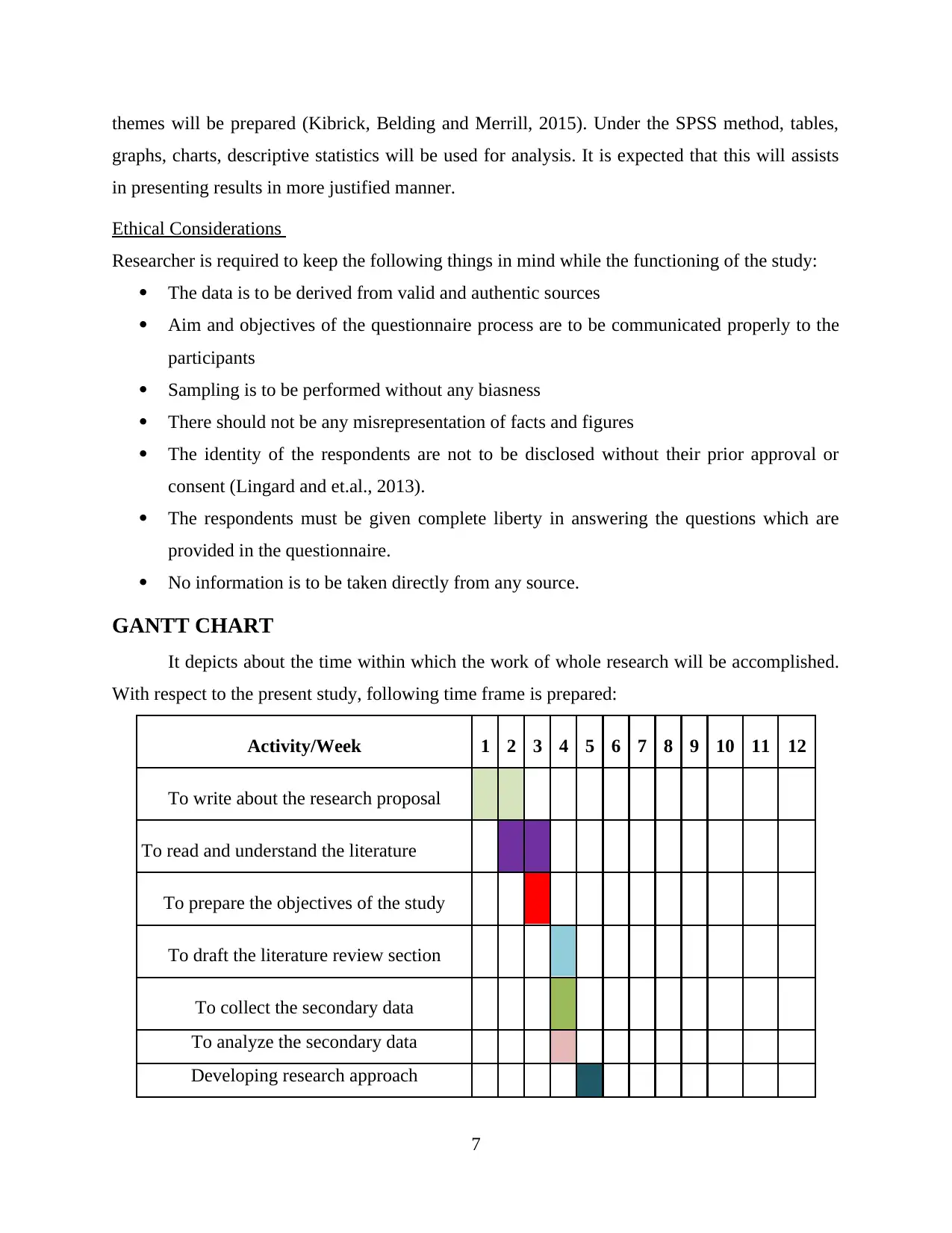
themes will be prepared (Kibrick, Belding and Merrill, 2015). Under the SPSS method, tables,
graphs, charts, descriptive statistics will be used for analysis. It is expected that this will assists
in presenting results in more justified manner.
Ethical Considerations
Researcher is required to keep the following things in mind while the functioning of the study:
The data is to be derived from valid and authentic sources
Aim and objectives of the questionnaire process are to be communicated properly to the
participants
Sampling is to be performed without any biasness
There should not be any misrepresentation of facts and figures
The identity of the respondents are not to be disclosed without their prior approval or
consent (Lingard and et.al., 2013).
The respondents must be given complete liberty in answering the questions which are
provided in the questionnaire.
No information is to be taken directly from any source.
GANTT CHART
It depicts about the time within which the work of whole research will be accomplished.
With respect to the present study, following time frame is prepared:
Activity/Week 1 2 3 4 5 6 7 8 9 10 11 12
To write about the research proposal
To read and understand the literature
To prepare the objectives of the study
To draft the literature review section
To collect the secondary data
To analyze the secondary data
Developing research approach
7
graphs, charts, descriptive statistics will be used for analysis. It is expected that this will assists
in presenting results in more justified manner.
Ethical Considerations
Researcher is required to keep the following things in mind while the functioning of the study:
The data is to be derived from valid and authentic sources
Aim and objectives of the questionnaire process are to be communicated properly to the
participants
Sampling is to be performed without any biasness
There should not be any misrepresentation of facts and figures
The identity of the respondents are not to be disclosed without their prior approval or
consent (Lingard and et.al., 2013).
The respondents must be given complete liberty in answering the questions which are
provided in the questionnaire.
No information is to be taken directly from any source.
GANTT CHART
It depicts about the time within which the work of whole research will be accomplished.
With respect to the present study, following time frame is prepared:
Activity/Week 1 2 3 4 5 6 7 8 9 10 11 12
To write about the research proposal
To read and understand the literature
To prepare the objectives of the study
To draft the literature review section
To collect the secondary data
To analyze the secondary data
Developing research approach
7
⊘ This is a preview!⊘
Do you want full access?
Subscribe today to unlock all pages.

Trusted by 1+ million students worldwide
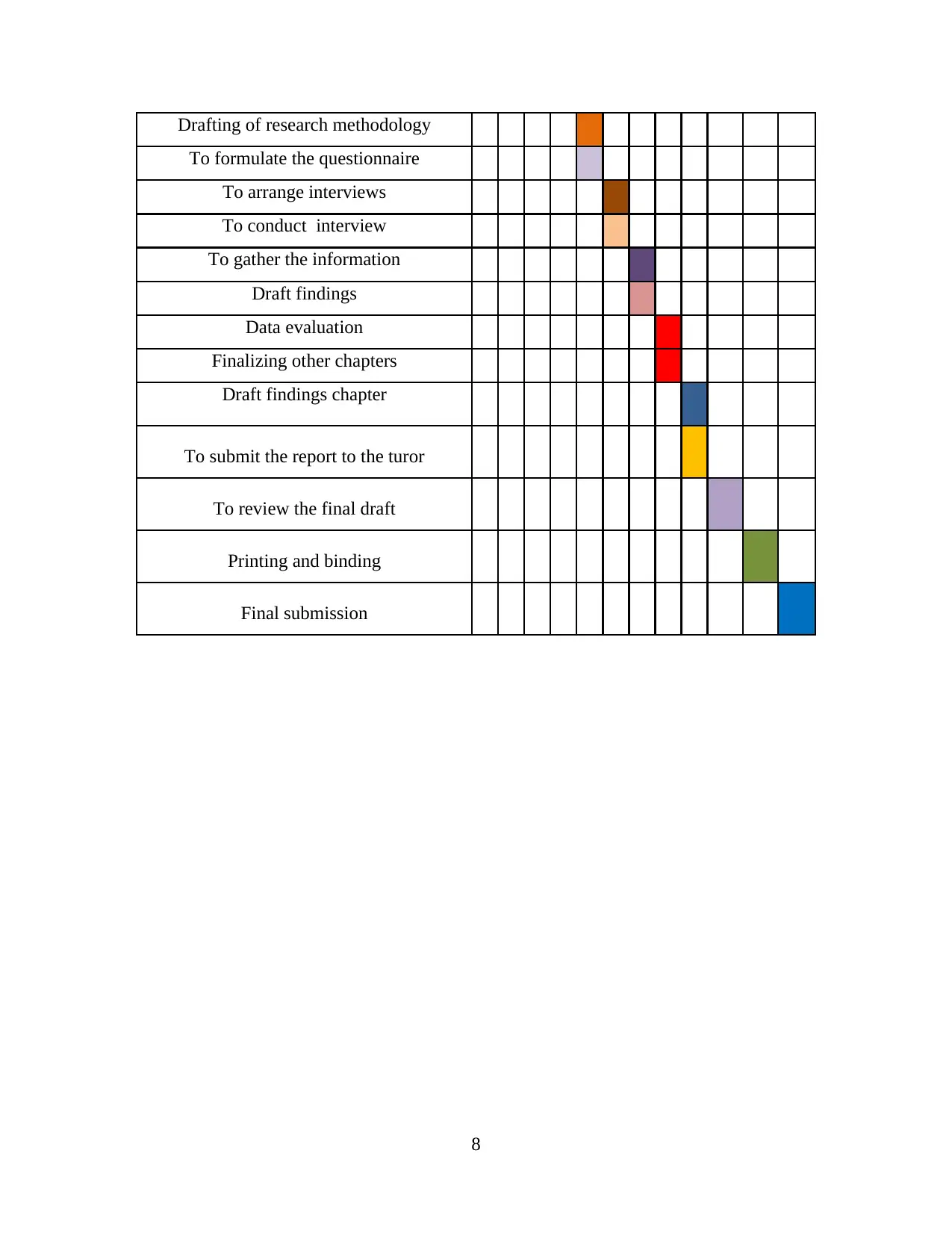
Drafting of research methodology
To formulate the questionnaire
To arrange interviews
To conduct interview
To gather the information
Draft findings
Data evaluation
Finalizing other chapters
Draft findings chapter
To submit the report to the turor
To review the final draft
Printing and binding
Final submission
8
To formulate the questionnaire
To arrange interviews
To conduct interview
To gather the information
Draft findings
Data evaluation
Finalizing other chapters
Draft findings chapter
To submit the report to the turor
To review the final draft
Printing and binding
Final submission
8
Paraphrase This Document
Need a fresh take? Get an instant paraphrase of this document with our AI Paraphraser
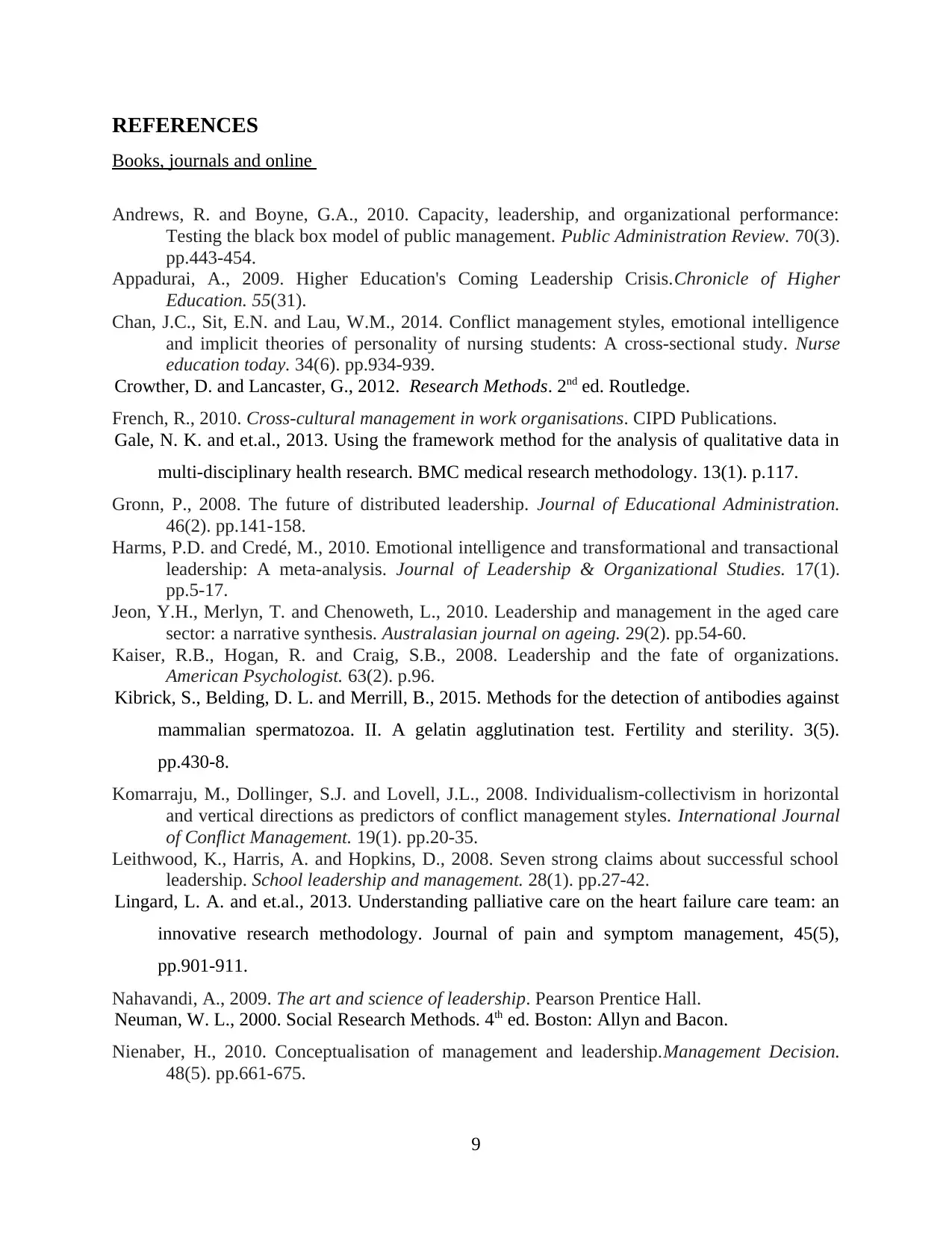
REFERENCES
Books, journals and online
Andrews, R. and Boyne, G.A., 2010. Capacity, leadership, and organizational performance:
Testing the black box model of public management. Public Administration Review. 70(3).
pp.443-454.
Appadurai, A., 2009. Higher Education's Coming Leadership Crisis.Chronicle of Higher
Education. 55(31).
Chan, J.C., Sit, E.N. and Lau, W.M., 2014. Conflict management styles, emotional intelligence
and implicit theories of personality of nursing students: A cross-sectional study. Nurse
education today. 34(6). pp.934-939.
Crowther, D. and Lancaster, G., 2012. Research Methods. 2nd ed. Routledge.
French, R., 2010. Cross-cultural management in work organisations. CIPD Publications.
Gale, N. K. and et.al., 2013. Using the framework method for the analysis of qualitative data in
multi-disciplinary health research. BMC medical research methodology. 13(1). p.117.
Gronn, P., 2008. The future of distributed leadership. Journal of Educational Administration.
46(2). pp.141-158.
Harms, P.D. and Credé, M., 2010. Emotional intelligence and transformational and transactional
leadership: A meta-analysis. Journal of Leadership & Organizational Studies. 17(1).
pp.5-17.
Jeon, Y.H., Merlyn, T. and Chenoweth, L., 2010. Leadership and management in the aged care
sector: a narrative synthesis. Australasian journal on ageing. 29(2). pp.54-60.
Kaiser, R.B., Hogan, R. and Craig, S.B., 2008. Leadership and the fate of organizations.
American Psychologist. 63(2). p.96.
Kibrick, S., Belding, D. L. and Merrill, B., 2015. Methods for the detection of antibodies against
mammalian spermatozoa. II. A gelatin agglutination test. Fertility and sterility. 3(5).
pp.430-8.
Komarraju, M., Dollinger, S.J. and Lovell, J.L., 2008. Individualism-collectivism in horizontal
and vertical directions as predictors of conflict management styles. International Journal
of Conflict Management. 19(1). pp.20-35.
Leithwood, K., Harris, A. and Hopkins, D., 2008. Seven strong claims about successful school
leadership. School leadership and management. 28(1). pp.27-42.
Lingard, L. A. and et.al., 2013. Understanding palliative care on the heart failure care team: an
innovative research methodology. Journal of pain and symptom management, 45(5),
pp.901-911.
Nahavandi, A., 2009. The art and science of leadership. Pearson Prentice Hall.
Neuman, W. L., 2000. Social Research Methods. 4th ed. Boston: Allyn and Bacon.
Nienaber, H., 2010. Conceptualisation of management and leadership.Management Decision.
48(5). pp.661-675.
9
Books, journals and online
Andrews, R. and Boyne, G.A., 2010. Capacity, leadership, and organizational performance:
Testing the black box model of public management. Public Administration Review. 70(3).
pp.443-454.
Appadurai, A., 2009. Higher Education's Coming Leadership Crisis.Chronicle of Higher
Education. 55(31).
Chan, J.C., Sit, E.N. and Lau, W.M., 2014. Conflict management styles, emotional intelligence
and implicit theories of personality of nursing students: A cross-sectional study. Nurse
education today. 34(6). pp.934-939.
Crowther, D. and Lancaster, G., 2012. Research Methods. 2nd ed. Routledge.
French, R., 2010. Cross-cultural management in work organisations. CIPD Publications.
Gale, N. K. and et.al., 2013. Using the framework method for the analysis of qualitative data in
multi-disciplinary health research. BMC medical research methodology. 13(1). p.117.
Gronn, P., 2008. The future of distributed leadership. Journal of Educational Administration.
46(2). pp.141-158.
Harms, P.D. and Credé, M., 2010. Emotional intelligence and transformational and transactional
leadership: A meta-analysis. Journal of Leadership & Organizational Studies. 17(1).
pp.5-17.
Jeon, Y.H., Merlyn, T. and Chenoweth, L., 2010. Leadership and management in the aged care
sector: a narrative synthesis. Australasian journal on ageing. 29(2). pp.54-60.
Kaiser, R.B., Hogan, R. and Craig, S.B., 2008. Leadership and the fate of organizations.
American Psychologist. 63(2). p.96.
Kibrick, S., Belding, D. L. and Merrill, B., 2015. Methods for the detection of antibodies against
mammalian spermatozoa. II. A gelatin agglutination test. Fertility and sterility. 3(5).
pp.430-8.
Komarraju, M., Dollinger, S.J. and Lovell, J.L., 2008. Individualism-collectivism in horizontal
and vertical directions as predictors of conflict management styles. International Journal
of Conflict Management. 19(1). pp.20-35.
Leithwood, K., Harris, A. and Hopkins, D., 2008. Seven strong claims about successful school
leadership. School leadership and management. 28(1). pp.27-42.
Lingard, L. A. and et.al., 2013. Understanding palliative care on the heart failure care team: an
innovative research methodology. Journal of pain and symptom management, 45(5),
pp.901-911.
Nahavandi, A., 2009. The art and science of leadership. Pearson Prentice Hall.
Neuman, W. L., 2000. Social Research Methods. 4th ed. Boston: Allyn and Bacon.
Nienaber, H., 2010. Conceptualisation of management and leadership.Management Decision.
48(5). pp.661-675.
9
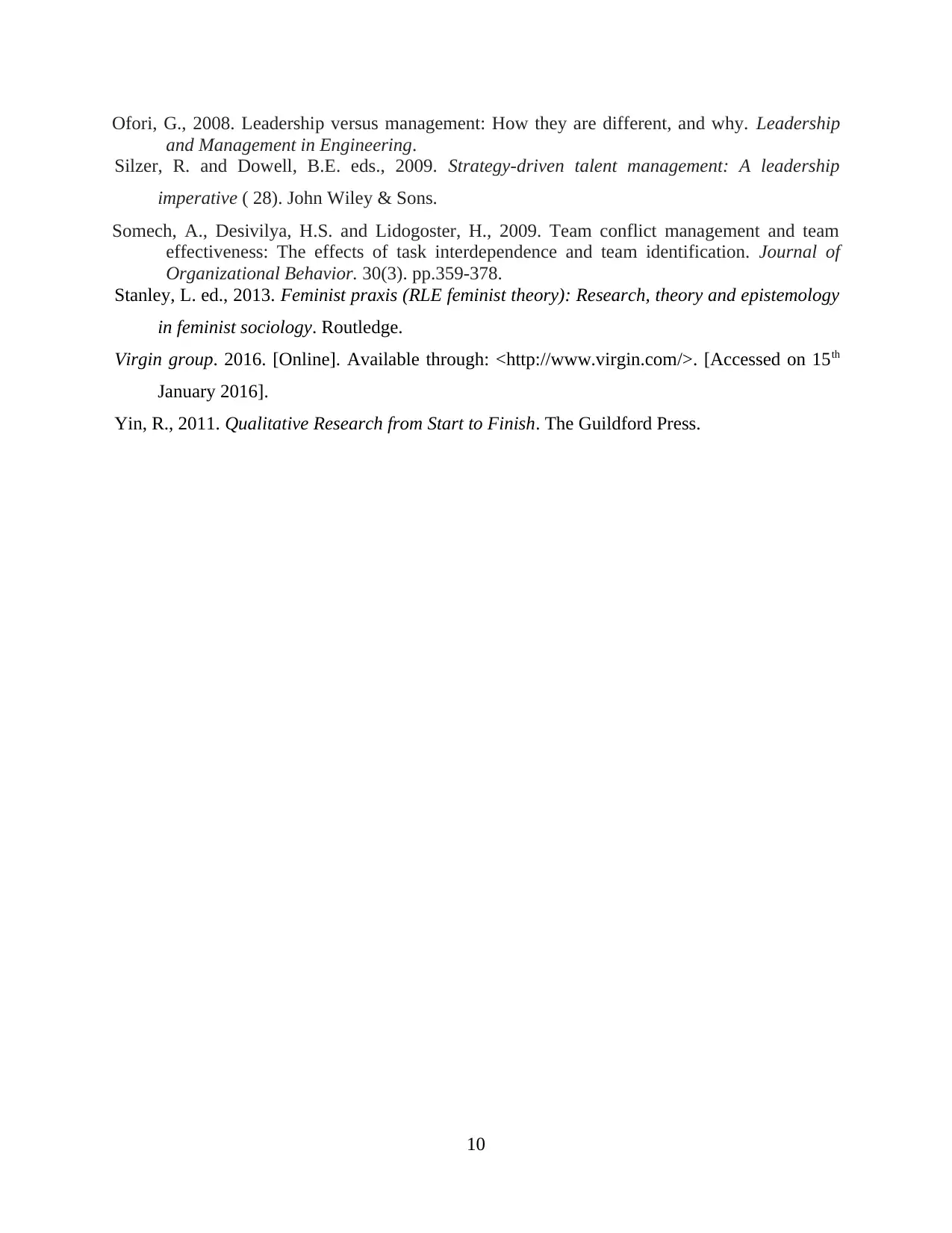
Ofori, G., 2008. Leadership versus management: How they are different, and why. Leadership
and Management in Engineering.
Silzer, R. and Dowell, B.E. eds., 2009. Strategy-driven talent management: A leadership
imperative ( 28). John Wiley & Sons.
Somech, A., Desivilya, H.S. and Lidogoster, H., 2009. Team conflict management and team
effectiveness: The effects of task interdependence and team identification. Journal of
Organizational Behavior. 30(3). pp.359-378.
Stanley, L. ed., 2013. Feminist praxis (RLE feminist theory): Research, theory and epistemology
in feminist sociology. Routledge.
Virgin group. 2016. [Online]. Available through: <http://www.virgin.com/>. [Accessed on 15th
January 2016].
Yin, R., 2011. Qualitative Research from Start to Finish. The Guildford Press.
10
and Management in Engineering.
Silzer, R. and Dowell, B.E. eds., 2009. Strategy-driven talent management: A leadership
imperative ( 28). John Wiley & Sons.
Somech, A., Desivilya, H.S. and Lidogoster, H., 2009. Team conflict management and team
effectiveness: The effects of task interdependence and team identification. Journal of
Organizational Behavior. 30(3). pp.359-378.
Stanley, L. ed., 2013. Feminist praxis (RLE feminist theory): Research, theory and epistemology
in feminist sociology. Routledge.
Virgin group. 2016. [Online]. Available through: <http://www.virgin.com/>. [Accessed on 15th
January 2016].
Yin, R., 2011. Qualitative Research from Start to Finish. The Guildford Press.
10
⊘ This is a preview!⊘
Do you want full access?
Subscribe today to unlock all pages.

Trusted by 1+ million students worldwide
1 out of 13
Related Documents
Your All-in-One AI-Powered Toolkit for Academic Success.
+13062052269
info@desklib.com
Available 24*7 on WhatsApp / Email
![[object Object]](/_next/static/media/star-bottom.7253800d.svg)
Unlock your academic potential
Copyright © 2020–2025 A2Z Services. All Rights Reserved. Developed and managed by ZUCOL.





